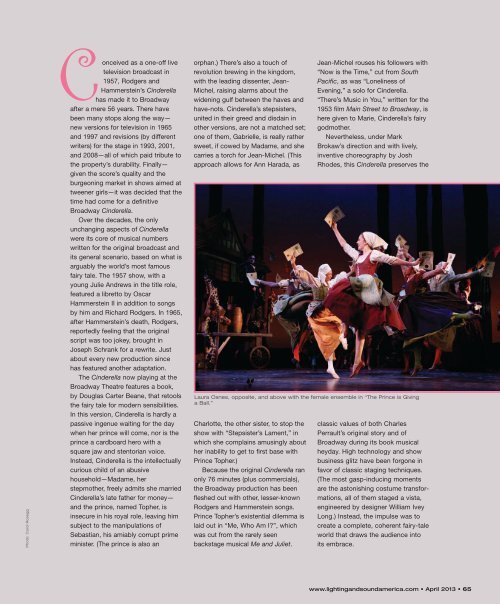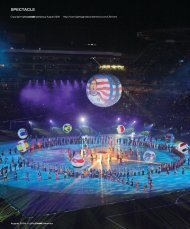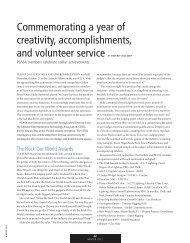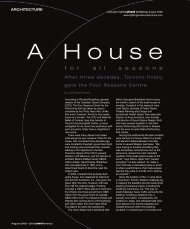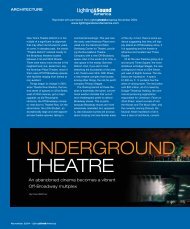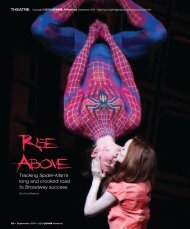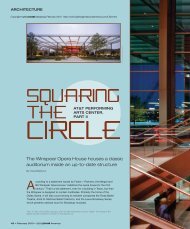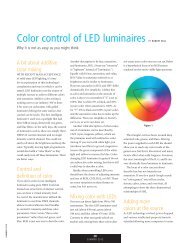Cinderella - Lighting & Sound America
Cinderella - Lighting & Sound America
Cinderella - Lighting & Sound America
Create successful ePaper yourself
Turn your PDF publications into a flip-book with our unique Google optimized e-Paper software.
Photo: Carol Rosegg<br />
Conceived as a one-off live<br />
television broadcast in<br />
1957, Rodgers and<br />
Hammerstein’s <strong>Cinderella</strong><br />
has made it to Broadway<br />
after a mere 56 years. There have<br />
been many stops along the way—<br />
new versions for television in 1965<br />
and 1997 and revisions (by different<br />
writers) for the stage in 1993, 2001,<br />
and 2008—all of which paid tribute to<br />
the property’s durability. Finally—<br />
given the score’s quality and the<br />
burgeoning market in shows aimed at<br />
tweener girls—it was decided that the<br />
time had come for a definitive<br />
Broadway <strong>Cinderella</strong>.<br />
Over the decades, the only<br />
unchanging aspects of <strong>Cinderella</strong><br />
were its core of musical numbers<br />
written for the original broadcast and<br />
its general scenario, based on what is<br />
arguably the world’s most famous<br />
fairy tale. The 1957 show, with a<br />
young Julie Andrews in the title role,<br />
featured a libretto by Oscar<br />
Hammerstein II in addition to songs<br />
by him and Richard Rodgers. In 1965,<br />
after Hammerstein’s death, Rodgers,<br />
reportedly feeling that the original<br />
script was too jokey, brought in<br />
Joseph Schrank for a rewrite. Just<br />
about every new production since<br />
has featured another adaptation.<br />
The <strong>Cinderella</strong> now playing at the<br />
Broadway Theatre features a book,<br />
by Douglas Carter Beane, that retools<br />
the fairy tale for modern sensibilities.<br />
In this version, <strong>Cinderella</strong> is hardly a<br />
passive ingenue waiting for the day<br />
when her prince will come, nor is the<br />
prince a cardboard hero with a<br />
square jaw and stentorian voice.<br />
Instead, <strong>Cinderella</strong> is the intellectually<br />
curious child of an abusive<br />
household—Madame, her<br />
stepmother, freely admits she married<br />
<strong>Cinderella</strong>’s late father for money—<br />
and the prince, named Topher, is<br />
insecure in his royal role, leaving him<br />
subject to the manipulations of<br />
Sebastian, his amiably corrupt prime<br />
minister. (The prince is also an<br />
orphan.) There’s also a touch of<br />
revolution brewing in the kingdom,<br />
with the leading dissenter, Jean-<br />
Michel, raising alarms about the<br />
widening gulf between the haves and<br />
have-nots. <strong>Cinderella</strong>’s stepsisters,<br />
united in their greed and disdain in<br />
other versions, are not a matched set;<br />
one of them, Gabrielle, is really rather<br />
sweet, if cowed by Madame, and she<br />
carries a torch for Jean-Michel. (This<br />
approach allows for Ann Harada, as<br />
Charlotte, the other sister, to stop the<br />
show with “Stepsister’s Lament,” in<br />
which she complains amusingly about<br />
her inability to get to first base with<br />
Prince Topher.)<br />
Because the original <strong>Cinderella</strong> ran<br />
only 76 minutes (plus commercials),<br />
the Broadway production has been<br />
fleshed out with other, lesser-known<br />
Rodgers and Hammerstein songs.<br />
Prince Topher’s existential dilemma is<br />
laid out in “Me, Who Am I”, which<br />
was cut from the rarely seen<br />
backstage musical Me and Juliet.<br />
Jean-Michel rouses his followers with<br />
“Now is the Time,” cut from South<br />
Pacific, as was “Loneliness of<br />
Evening,” a solo for <strong>Cinderella</strong>.<br />
“There’s Music in You,” written for the<br />
1953 film Main Street to Broadway, is<br />
here given to Marie, <strong>Cinderella</strong>’s fairy<br />
godmother.<br />
Nevertheless, under Mark<br />
Brokaw’s direction and with lively,<br />
inventive choreography by Josh<br />
Rhodes, this <strong>Cinderella</strong> preserves the<br />
Laura Osnes, opposite, and above with the female ensemble in “The Prince is Giving<br />
a Ball.”<br />
classic values of both Charles<br />
Perrault’s original story and of<br />
Broadway during its book musical<br />
heyday. High technology and show<br />
business glitz have been forgone in<br />
favor of classic staging techniques.<br />
(The most gasp-inducing moments<br />
are the astonishing costume transformations,<br />
all of them staged a vista,<br />
engineered by designer William Ivey<br />
Long.) Instead, the impulse was to<br />
create a complete, coherent fairy-tale<br />
world that draws the audience into<br />
its embrace.<br />
www.lightingandsoundamerica.com • April 2013 • 65


